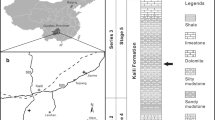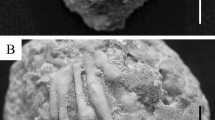Abstract
Chrysopetalids, more specifically the subfamily Chrysopetalinae, are known for their characteristic, flattened, leaf-like notopodial chaetae. In many chrysopetalid species the animal’s body is dorsally covered by these paleae that are arranged in rows similar to the blades of a folding fan. In this study we investigate and compare the chaetal arrangement in two chrysopetalids: Bhawania goodei Webster, 1884 and Chrysopetalum cf. occidentale Johnson, 1897, using serial sectioning and 3D models. Our results reveal details on the topology of the chaetal formative site, where chaetogenesis occurs continuously. The course of chaetogenesis is significantly affected by the very large size of the chaetae, but nevertheless follows the general pattern of chaetogenesis in Annelida. Ultrastructure of the paleae confirms previous observations. The results of the study are the first on chaetogenesis and chaetal topology in a representative of the Phyllodocida. They indicate differences in the number of formative sites in neuro- and notopodia that now need to be studied in a larger number phyllodocid taxa. A special focus has been laid on details of paleal formation to study potential phylogenetic affinities between Wiwaxia and Chrysopetalidae that were proposed due to the significant similarity of the paleae to the sclerites of Wiwaxia.







Similar content being viewed by others
References
Aguado MT, Nygren A, Rouse GW (2013) Two apparently unrelated groups of symbiotic annelids, Nautiliniellidae and Calamyzidae (Phyllodocida, Annelida), are a clade of derived chrysopetalid polychaetes. Cladistics 29:610–628. https://doi.org/10.1111/cla.12011
Andrade SCS, Novo M, Kawauchi GY, Worsaae K, Pleijel F, Giribet G, Rouse GW (2015) Articulating “archiannelids”: phylogenomics and annelid relationships, with emphasis on meiofaunal taxa. Mol Biol Evol. https://doi.org/10.1093/molbev/msv157
Bartolomaeus T (1998) Chaetogenesis in polychaetous Annelida: significance for annelid systematics and the position of the Pogonophora. Zoology 100:348–364
Blumer MJF, Gahleitner P, Narzt T, Handl C, Ruthensteiner B (2002) Ribbons of semithin sections: an advanced method with a new type of diamond knife. J Neurosci Methods 120:11–16
Bouligand Y (1967) Les soies et les cellules associées chez deux Annélides Polychètes. Zeitschrift für Zellforsch mikroskopische Anat 79(3):332–363
Butterfield NJ (1990) A reassessment of the enigmatic Burgess Shale fossil Wiwaxia corrugata (Matthew) and its relationship to the polychaete Canadia spinosa Walcott. Paleobiology 16:287–303. https://doi.org/10.2307/2400789
Butterfield NJ (2003) Exceptional fossil preservation and the Cambrian explosion. Integr Comp Biol 43:166–177. https://doi.org/10.1093/icb/43.1.166
Butterfield NJ (2006) Hooking some stem-group “worms”: fossil lophotrochozoans in the Burgess Shale. BioEssays 28:1161–1166. https://doi.org/10.1002/bies.20507
Caron JB, Scheltema A, Schander C, Rudkin D (2007) Reply to Butterfield on stem-group “worms”: fossil lophotrochozoans in the Burgess Shale. BioEssays 29:200–202. https://doi.org/10.1002/bies.20527
Conway Morris S (1985) The Middle Cambrian metazoan Wiwaxia corrugata (Matthew) from the Burgess Shale and Ogygopsis Shale, British Columbia, Canada. Philos Trans R Soc B Biol Sci 307:507–582. https://doi.org/10.1098/rstb.1985.0005
Eibye-Jacobsen D (2004) A reevaluation of Wiwaxia and the polychaetes of the Burgess Shale. Lethaia 37(3):317–335. https://doi.org/10.1080/00241160410002027
Grobe P, Vogt L (2009) Morph.D.Base 2.0. In: A public date base Morphol. Data, metadata, phylogenetic matrices. http://www.morphdbase.de. Accessed 24 Jan 2019
Hausen H, Bartolomaeus T (1998) Setal Structure and Chaetogenesis in Scolelepis squamata and Malacoceros fuliginosus (Spionidae, Annelida). Acta Zool 79:149–161. https://doi.org/10.1111/j.1463-6395.1998.tb01154.x
Hausen H (2001) Untersuchungen zur Phylogenie “spiomorpher” Polychaeten (Annelida). Universitaet Bielefeld, Bielefeld
Hausen H (2005) Chaetae and chaetogenesis in polychaetes (Annelida). Hydrobiologia 535–536:37–52
Kocot KM, Struck TH, Merkel J, Waits DS, Todt C, Brannock PM, Weese DA, Cannon JT, Moroz LL, Lieb B, Halanych KM (2017) Phylogenomics of Lophotrochozoa with consideration of systematic error. Syst Biol 66(2):256–282. https://doi.org/10.1093/sysbio/syw079
Kolbasova GD, Tzetlin AB, Kupriyanova EK (2014) Chaetal loss and replacement in Pseudopotamilla reniformis (Sabellida, Annelida). Invertebr Biol 133:261–273. https://doi.org/10.1111/ivb.12061
Matthew GF (1899) Studies on Cambrian Faunas, No. 3. Upper Cambrian Fauna of Mount Stephen, British Columbia. The Trilobites and Worms. Trans R Soc Can 5:39–66
Merz RA, Woodin S (2006) Polychaete chaetae: function, fossils, and phylogeny. Integr Comp Biol 46:481–496. https://doi.org/10.1093/icb/icj057
O’Clair R, Cloney R (1974) Patterns of morphogenesis mediated by dynamic microvilli: chaetogenesis in Nereis vexillosa. Cell Tissue Res 151(2):141–157. https://doi.org/10.1007/BF00222219
Perkins TH (1985) Chrysopetalum, Bhawania and two new genera of Chrysopetalidae (Polychaeta), principally from Florida. Proc Biol Soc Wash 98:856–915
Pleijel F, Gustavsson L (2010) Chambered chaetae in nereidiform polychaetes (Annelida). Zoomorphology 129:93–98. https://doi.org/10.1007/s00435-010-0102-z
Rouse GW, Pleijel F (2001) Polychaetes. Oxford University Press, Oxford
Scheltema AH (2014) The original molluscan radula and progenesis in Aplacophora revisited. J Nat Hist 48(45–48):2855–2869. https://doi.org/10.1080/00222933.2014.959573
Scheltema AH, Kerth K, Kuzirian AM (2003) Original molluscan radula: comparisons among Aplacophora, Polyplacophora, Gastropoda, and the Cambrian fossil Wiwaxia corrugata. J Morphol 257:219–244. https://doi.org/10.1002/jmor.10121
Schweigkofler M, Bartolomaeus T, von Salvini-Plawen L (1998) Ultrastructure and formation of hooded hooks in Capitella capitata (Annelida, Capitellida). Zoomorphology 118:117–128. https://doi.org/10.1007/s004350050062
Smith MR (2012) Mouthparts of the Burgess Shale fossils Odontogriphus and Wiwaxia: implications for the ancestral molluscan radula. Proc R Soc B Biol Sci 279:4287–4295. https://doi.org/10.1098/rspb.2012.1577
Smith MR (2014) Ontogeny, morphology and taxonomy of the soft-bodied Cambrian ‘mollusc’ Wiwaxia. Palaeontology 57(1):215–229. https://doi.org/10.1111/pala.12063
Tilic E, Hausen H, Bartolomaeus T (2014) Chaetal arrangement and chaetogenesis of hooded hooks in Lumbrineris (Scoletoma) fragilis and Lumbrineris tetraura (Eunicida, Annelida). Invertebr Biol 133:354–370. https://doi.org/10.1111/ivb.12066
Tilic E, Lehrke J, Bartolomaeus T (2015) Homology and Evolution of the Chaetae in Echiura (Annelida). PLoS One 10(3):e0120002. https://doi.org/10.1371/journal.pone.0120002
Tilic E, Bartolomaeus T (2016) Structure, function and cell dynamics during chaetogenesis of abdominal uncini in Sabellaria alveolata (Sabellariidae, Annelida). Zool Lett 2:1. https://doi.org/10.1186/s40851-016-0037-4
Tilic E, Pauli B, Bartolomaeus T (2017) Getting to the root of fireworms’ stinging chaetae—chaetal arrangement and ultrastructure of Eurythoe complanata (Pallas, 1766) (Amphinomida). J Morphol 278:865–876. https://doi.org/10.1002/jmor.20680
Walcott CD (1911) No. 5 Middle Cambrian Annelids. Cambrian Geology and Paleontology II. Smithson Misc Collect 57:109–144
Watson C (2015) Seven new species of Paleanotus (Annelida: Chrysopetalidae) described from Lizard Island, Great Barrier Reef, and coral reefs of northern Australia and the Indo-Pacific: two cryptic species pairs revealed between western Pacific Ocean and the eastern Indian Ocean. Zootaxa 4019:707–732. https://doi.org/10.11646/zootaxa.4019.1.24
Watson-Russell C (1986) Paleaequor, a new genus of polychaete worm (Chrysopetalidae). Rec Aust Museum 38:153–174. https://doi.org/10.3853/j.0067-1975.38.1986.180
Watson-Russell C (1997) Patterns of growth and setal developement in the deep-sea worm Strepternos didymopyton (Polychaeta: Chrysopetalidae). Bull Mar Sci 60(2):405–426
Watson C, Ignacio Carvajal J, Sergeeva NG, Pleijel F, Rouse G (2016) Free-living calamyzin chrysopetalids (Annelida) from methane seeps, anoxic basins, and whale falls. Zool J Linn Soc 177:700–719. https://doi.org/10.1111/zoj.12390
Weigert A, Helm C, Meyer M, Nickel B, Arendt D, Hausdorf B, Santos SR, Halanych KM, Purschke G, Bleidorn C, Struck TH (2014) Illuminating the base of the annelid tree using transcriptomics. Mol Biol Evol 31:1391–1401. https://doi.org/10.1093/molbev/msu080
Weigert A, Bleidorn C (2016) Current status of annelid phylogeny. Org Divers Evol. https://doi.org/10.1007/s13127-016-0265-7
Westheide W, Russell CW (1992) Ultrastructure of chrysopetalid paleal chaetae (Annelida, Polychaeta). Acta Zool 73:197–202. https://doi.org/10.1111/j.1463-6395.1992.tb01187.x
Yang J, Smith MR, Lan T, Hou JB, Zhang XG (2014) Articulated Wiwaxia from the Cambrian Stage 3 Xiaoshiba lagerstätte. Sci Rep 4:4643. https://doi.org/10.1038/srep04643
Zhang Z, Smith MR, Shu D (2015) New reconstruction of the Wiwaxia scleritome, with data from Chengjiang juveniles. Sci Rep 5:14810. https://doi.org/10.1038/srep14810
Acknowledgements
We would like to thank Dr. Charlotte Watson for her help with the identification of the studied species and for her very helpful comments during the revision of this paper. Furthermore, we thank Dr. Elise Jaschabek-Laetz who let us roam through her “live rocks” from Florida looking for polychaetes and Dr. Viktor Starunov who kindly provided us with the Chrysopetalum cf. occidentale specimens from Vostok. Our sincere gratitude is also due to Tatjana Bartz for her technical assistance in the lab and to Marina McCowin for the live photo of Chrysopetalum occidentale.
Author information
Authors and Affiliations
Corresponding author
Ethics declarations
Conflict of interest
The authors received no specific funding for this work and they declare that they have no conflict of interest.
Ethical approval
We neither used endangered species nor were the investigated animals collected in protected areas. All applicable international, national, and/or institutional guidelines for the care and use of animals were followed.
Additional information
Publisher’s Note
Springer Nature remains neutral with regard to jurisdictional claims in published maps and institutional affiliations.
Rights and permissions
About this article
Cite this article
Tilic, E., Sermelwall, S. & Bartolomaeus, T. Formation and structure of paleae and chaetal arrangement in chrysopetalidae (Annelida). Zoomorphology 138, 209–220 (2019). https://doi.org/10.1007/s00435-019-00435-7
Received:
Revised:
Accepted:
Published:
Issue Date:
DOI: https://doi.org/10.1007/s00435-019-00435-7




